Menu
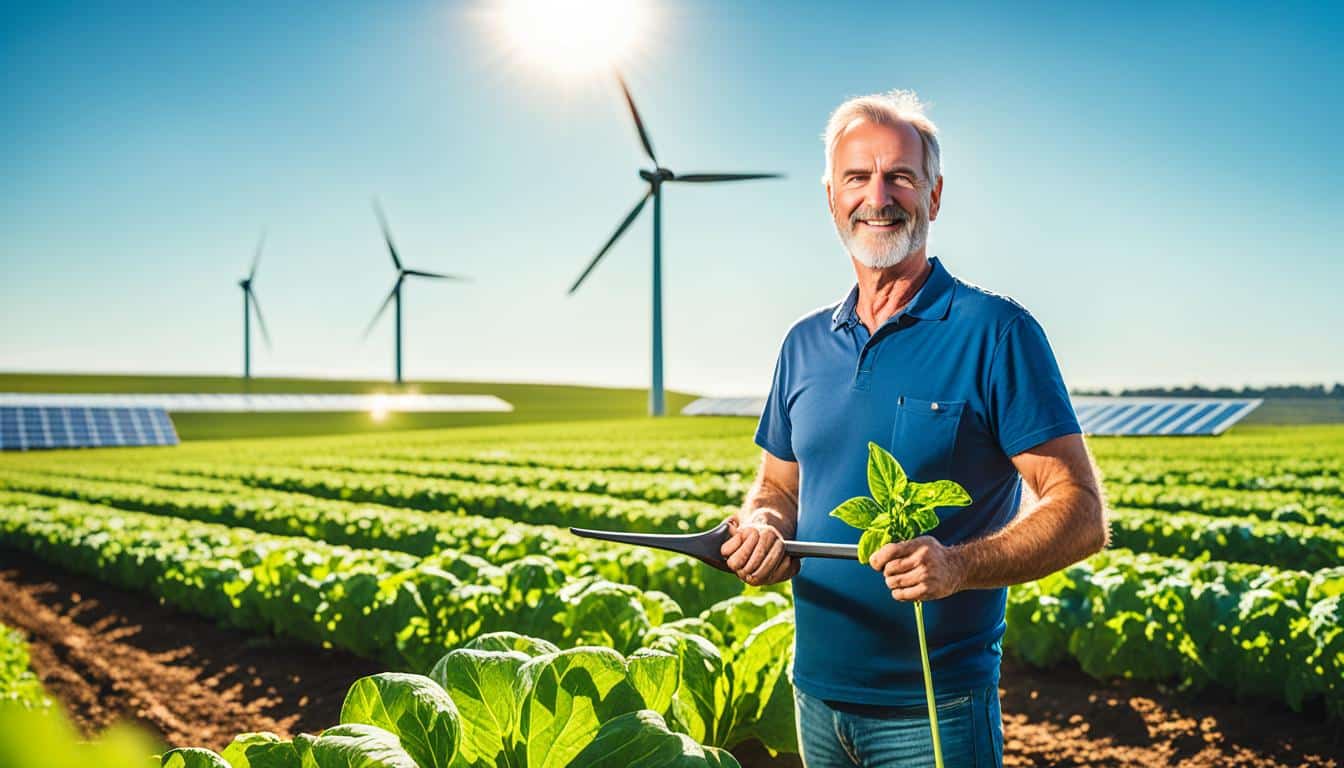
Over the last 35 years, the Sustainable Agriculture Research and Education (SARE) programme has given $380 million. This has helped nearly 8,400 projects all over the United States. This large investment shows how important it is to get funding for sustainable farming. It helps make the environment better, keeps farms running well, and gives a better life to farmers and the community.
Sustainable agriculture, as defined by the U.S. Code Title 7, Section 3103, is a way of farming. It aims to meet our food and fibre needs while improving the environment and making the best use of resources. There are many funding options available. These include government grants and educational programmes for those who want to farm in an eco-friendly way.
Sustainable farming includes many practices that are proven by science. For example, using tools for pest management lowers risks to the economy and environment. It also gives examples like soil conservation to stop erosion. Other practices, such as planting buffer strips near water and using cover crops to fight weeds and erosion, help farming stay sustainable.
Sustainable agriculture means meeting today’s needs without hurting how future people can meet their own needs. The definition by the U.S. Code Title 7, Section 3103, points out the need to balance meeting people’s needs with caring for the environment.
Sustainable agriculture, as defined, is a system that combines many practices for the health of the planet, profits, and fairness. The Farm Bill, part of the Agriculture Improvement Act of 2018, supports this unified effort. It helps in many areas like conservation and guiding the use of funds for these sustainable methods.
Greener farming is very important for many reasons. It does more than grow food. It uses resources better, supports nature’s cycles, and helps farms stay in business. The Farm Bill supports these aims, with about $428 billion going to such efforts over five years.
The Farm Bill operation, like Reauthorization and Appropriations, shows a clear and steady focus on sustainable farming. Key parts, such as the SNAP programme, get secure funding, showing how valuable these sustainable methods are.
In today’s world, sustainable farming is crucial. Many government grants help farmers use eco-friendly methods. These grants meet different needs and help in developing green agriculture.
There are various grants at the federal level for sustainable farming. For example, the Beginning Farmer and Rancher Development Program offers money for training. This is by groups like non-profits and schools. Also, Direct and Guaranteed Farm Loans help family farmers, especially new and those in need of support. They help in buying land and equipment through direct or government-backed loans.
Down Payment Loans offer a way for farmers to get low-interest help buying farms. These help people starting out, those who are disadvantaged or even women. Another aid is through Microloans, supporting small farms with loans up to $50,000. This helps young and new farmers grow their operations.
The Conservation Reserve Program boosts sustainable land use by paying landowners. It encourages leasing or selling to new or disadvantaged farmers. The Agricultural Conservation Easement Program helps keep wetlands, grasslands, and farms safe. It does this by offering easements for conservation.
For farmers with different crops or livestock, the Whole Farm Revenue Protection is useful. It protects income from all the farm’s products. Another initiative is the Healthy Food Financing Initiative. It helps make good food more available in communities that need it. This is through grants and support.
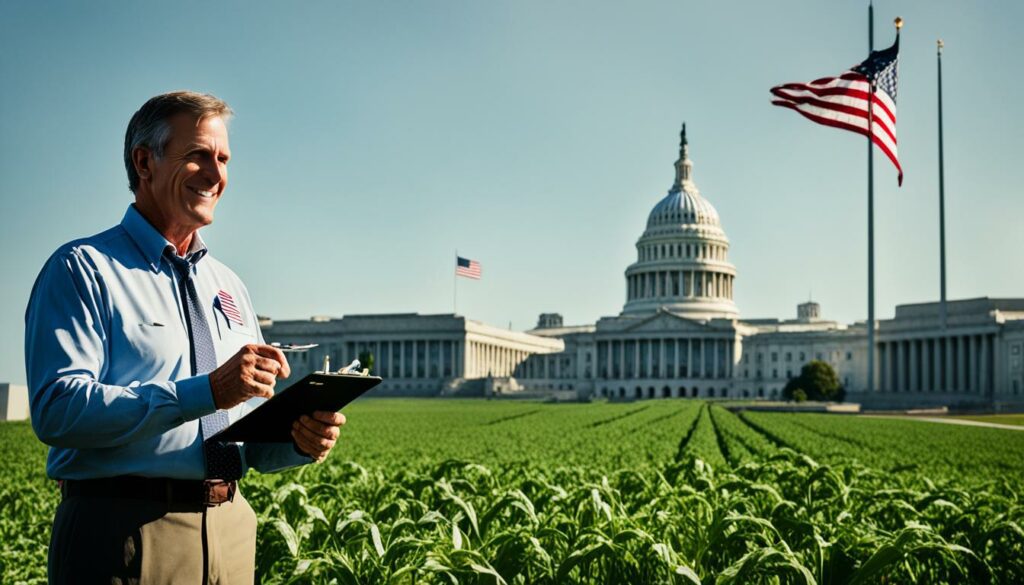
To get a grant, there are special rules to follow. For instance, for loans like Down Payment, you usually need to be new to farming or in need. Most grants require that farmers use eco-friendly methods.
Working with non-profits can make you more likely to get a grant. For grants like Farm to School Grants, you must team up with others. You work to bring local food into schools and teach kids about farming and healthy eating.
Here is a detailed comparison of various government grants available for sustainable agriculture:
| Grant | Target Group | Purpose | Funding Amount |
|---|---|---|---|
| Beginning Farmer and Rancher Development Program | Beginning Farmers and Ranchers | Training Projects | Varies |
| Direct and Guaranteed Farm Loans | Family Farmers | Farmland, Equipment Purchase | Depends on Loan Type |
| Down Payment Loans | Beginning, Minority, Women Farmers | Farm/Ranch Acquisition | Low Interest Loans |
| Microloans | Small, Diversified Farmers | Varied Farming Operations | Up to $50,000 |
| Conservation Reserve Program | Landowners | Sustainable Practices | Additional Payments |
Government grants are key in supporting eco-friendly farming. They help farmers go green and secure their future.
Environmental funding schemes help farmers use sustainable ways to fight climate change. These programmes, like the RCPP and climate-smart agriculture initiatives, aim to keep farming profitable.
The RCPP shows how funding can improve agriculture and nature together. It uses teamwork to make better use of resources and improve the environment. Through controlling pests and taking care of the soil, it helps farms stay healthy.
It also uses different plants and features of the land to offer better protection and preserve water and nature. These projects follow guidelines on sustainable farming to ensure we meet food needs, use resources carefully, and make life better for everyone.
Funding for climate-smart agriculture is essential. It encourages farmers to use methods that save money and create new ways to earn. For example, farmers are told to let animals graze in different fields and protect soil with cover crops.
Also, it supports planning for trees on farms and managing nutrients well. These actions are key in keeping the environment safe and farms running well. Programs like SARE and the Agriculture and Food Research Initiative provide support and research for these methods.
| Sustainable Farming Practices | Goals |
|---|---|
| Integrated Pest Management (IPM) | Manage pests without harming the environment |
| Rotational Grazing | Offer good food and save on feeding costs |
| Soil Conservation | Stop soil damage with varied crops |
| Water Quality/Wetlands Conservation | Keep water and wetlands safe |
| Cover Crops | Kill weeds and improve soil |
| Crop/Landscape Diversity | Lessen risks and help the environment |
| Nutrient Management | Make soil better and protect the environment |
| Agroforestry | Put trees on farms for many benefits |
| Alternative Marketing | Sell directly and support local farming |
Farm subsidies and sustainable agriculture incentives help eco-friendly farms. These programmes aim to promote farm sustainability.
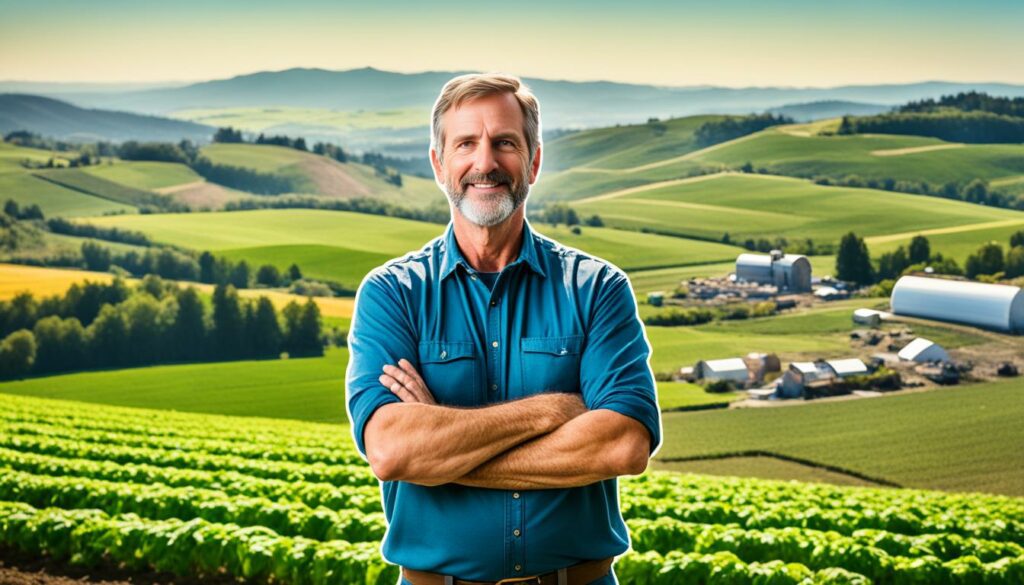
Farmers can access subsidies for eco-friendly farming. The Environmental Quality Incentives Program (EQIP) supports conservation practices. The Conservation Stewardship Program (CSP) rewards green efforts. To get grants, operations must be of high quality and sustainable.
Sticking to sustainable practices can benefit the environment and the farm. Integrated Pest Management (IPM) lessens pest risks. Rotational grazing saves on feed and controls manure. Soil conservation like no-till farming stops soil erosion.
Grains from cover crops after harvest help in many ways. They suppress weeds, prevent soil loss, and boost soil health.
| Practice | Benefits |
|---|---|
| Integrated Pest Management (IPM) | Reduces pest-related risks |
| Rotational Grazing | Rebalances feed intake, manages manure |
| Soil Conservation | Stops soil erosion |
| Cover Crops | Stifles weeds, keeps soil in place, enhances soil |
| Nutrient Management | Bolsters soil health, lowers fertiliser use |
| Crop/Landscape Diversity | Lessens risk from pests, weather, and market |
And don’t forget nutrient management and agroforestry. Also, try selling directly or through community support. These efforts help farms access grants for a sustainable future.
The USDA supports rural development. It offers grants and loans to help agricultural producers and improve rural Americans’ lives. These include loans for rural housing and funds for new market projects. They aim to boost sustainable farming.
Applying for agriculture grants requires understanding the process. It’s important for those such as new farmers, the disadvantaged, and vets. You will need to match the criteria, which often means being sustainable.
The USDA works with rural areas to fund important projects. Key programs involve:
Grant programs have led to successful farming projects. For example, the SCBGP boosts specialty crops’ competition. It and similar programs create jobs and make farming more sustainable. The FMPP has also grown farmers’ markets and supported agriculture locally.
Organic farmers benefit from AMS’s certification cost-share programs. These programs help lower marketing costs. They show how grants improve farming’s future.
| Program | Description | Target Group |
|---|---|---|
| Multi-Family Housing Programs | Gives loans for affordable rental housing. | Low- and moderate-income families, elderly, disabled |
| Farm Service Agency | Aids new farmers with loan funds. | Beginning farmers and ranchers |
| Risk Management Agency | Runs crop insurance for a stable farm economy. | Agricultural producers |
| FSMIP | Gives funds for market opportunities and innovation. | State Departments of Agriculture |
| SCBGP | Improves specialty crop competitiveness. | Specialty crop producers |
| FMPP | Boosts farmers markets and agriculture support. | Market organisers and farmers |
In summary, these grants help transform farms with sustainable methods. Knowing how to apply and use the programs well can boost a farmer’s business and help the environment.
Green finance for farmers is becoming more popular, now valued at $35.3 trillion. It’s a key part of the financial world. While not the biggest share, agriculture has a lot of room to grow in green finance.
Sustainable Supply Chain Finance (SCF) is a big player. It’s worth $1.3 trillion and could make farming more sustainable. Imagine the difference it could make.
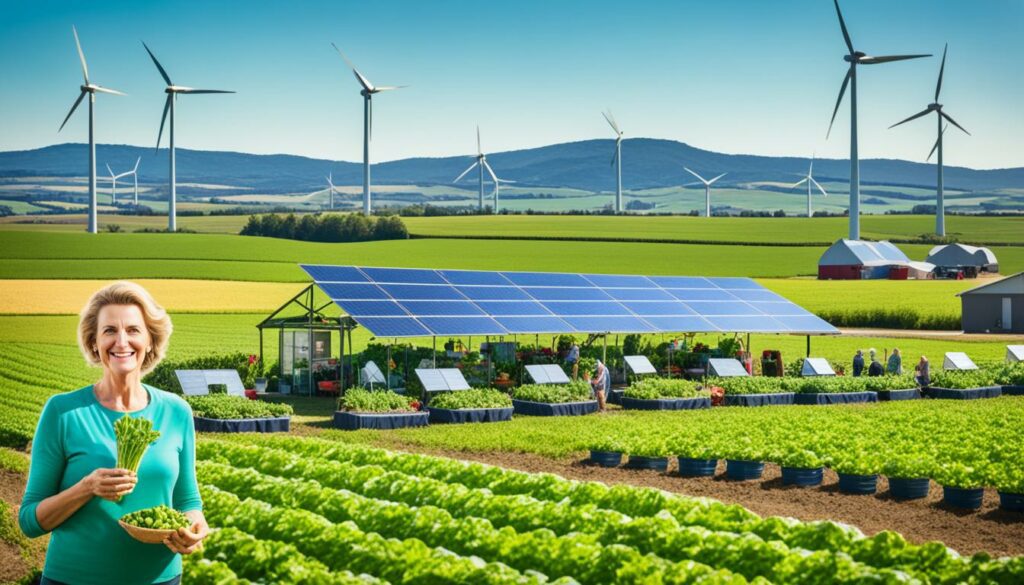
Green finance helps support farming that’s good for the planet. It’s especially important for farmers who want to use renewable energy, save water, and protect the soil. Through this, they can get money that helps the environment too.
Agricultural green loans are really important for moving towards sustainable farming. They allow farmers to buy things like solar panels and better water systems. This all helps the planet and can be less costly thanks to green finance.
Big financial institutions and others are starting to care more about eco-friendly farming. For example, the GFI’s Farming Toolkit helps farmers use resources wisely. And, partners like NatWest Bank and Tesco are jumping in to support these efforts.
Using green finance in farming is a win-win. It’s good for the earth and helps the farm’s bottom line. With the right financial support, farming can be sustainable and profitable in the long run.
Farmers find many funding options for sustainable practices. Federal and state programs offer help for various farming tasks. This funding makes a huge difference for farmers going green.
The USDA runs programs to boost eco-friendly farming. The Environmental Quality Incentives Program (EQIP) and Conservation Stewardship Program (CSP) help with money and advice. They’re for farmers improving land conservation methods.
The USDA also supports organic farming with the Organic Agriculture Research and Extension Initiative (OREI). This program gives $44 million in grants for organic practices.
They also offer the Risk Management Education Partnership Program (RMEPP) and the Beginning Farmer and Rancher Development Program (BFRDP). These give millions for education and starting new farms. This funding helps reach long-term environment and economy goals.
States have their own grants to help local farmers. These grant programs target local needs. For example, Boulder County’s Local Food and Agriculture grant offers funds for various farming areas.
Other programs, like the Rural Business Development or Urban Agriculture grants, are key. They provide essential support for sustainable developments. These programs show a broad commitment to making farming greener at the ground level.
By using these funding options, farmers can get the support needed for sustainable farming. This kind of support shows that working together supports a stronger, greener farm system.
Getting sustainable farming finance is key for bettering the environment and making farms more economically stable. This aid includes help like government grants and advice for green farming.
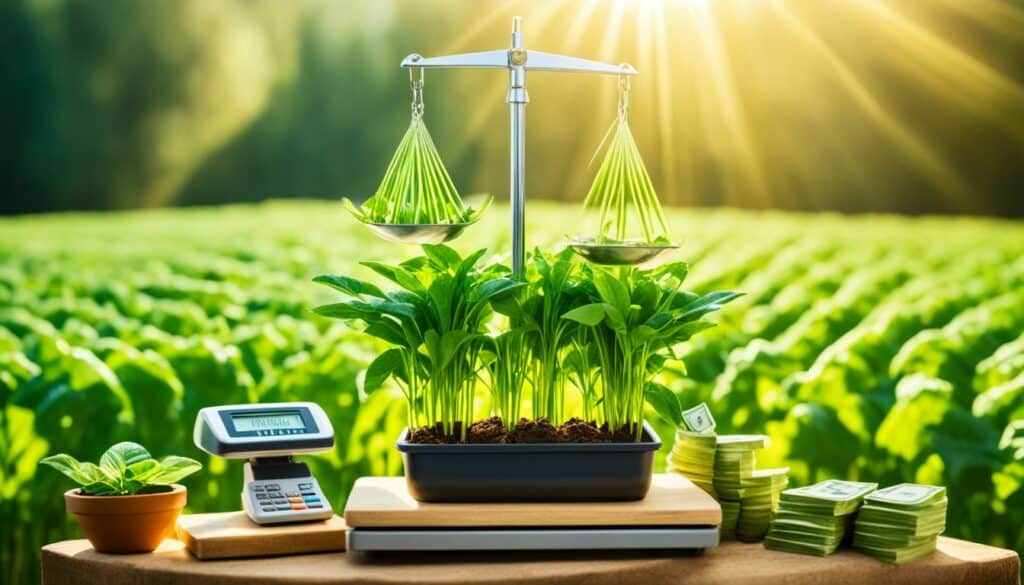
The U.S. defines sustainable agriculture as one that meets our need for food and fibre. It also must improve the environment and save natural resources. Achieving these aims needs smart money solutions.
For sustainable farming finance, one vital part is Integrated Pest Management (IPM). IPM helps farmers use different methods to keep pests under control. This reduces the risks to money, health, and the environment. Rotational grazing is also important. It offers good food for animals and cuts feed costs by keeping the land fresh.
Help from agricultural sustainability grants goes to soil-saving methods and saving water. For example, strip cropping stops soil from washing away. Planting protective strips near water helps too. Cover crops like rye and clover help soil and also keep weeds down.
| Practice | Benefits | Funding Mechanisms |
|---|---|---|
| Integrated Pest Management (IPM) | Minimises risks to economy, health, and environment | Government grants, technical support |
| Rotational Grazing | Provides high-quality forage, reduces feed costs | Subsidies, cost-share programmes |
| Soil Conservation | Prevents soil erosion | Direct grants, conservation incentives |
| Water Conservation | Improves water quality, protects wetlands | Environmental Quality Incentives Program (EQIP) |
| Cover Crops | Suppression of weeds, improved soil nutrients | Sustainable agriculture grants |
Different crops and landscapes make it harder for bad weather and pests to hurt the soil. Controlling nutrients keeps the environment safe. Adding trees to farms makes a cooler, diverse growing space.
Many grants and loans back these good practices. The Environmental Quality Incentives Program (EQIP) Organic Initiative and the High Tunnel Initiative help farmers do the right thing. The Regional Conservation Partnership Program (RCPP) lets groups team up with the USDA for saving the land together.
For direct support, microloans and other small loans up to $50,000 help different kinds of farmers. Programs for building farm storage and protecting crops after disasters are there. These include support for new and disadvantaged farmers.
There’s a lot of funding for eco-friendly farming available. Knowing how to apply for this aid is crucial. By using these funds well, farmers can help farming last for the future.
Using agri-environment funding wisely is key for sustainable farming. Farmers should plan carefully and put plans into action. This helps get the most from what’s available.
The best approach for these schemes involves several steps. This includes in-depth project planning and environmental checks. It also means working closely with agricultural groups to use resources better. Monitoring progress regularly and getting feedback adjusts practices for the best results.
Looking at real farming stories shows how agri-environment funds can make a difference. For example, they can improve organic farming and help reach new markets.
| Programme | Funding Amount | Key Outcomes |
|---|---|---|
| Organic Agriculture Research and Extension Initiative (OREI) | $44 million | Enhanced organic farming techniques and market reach. |
| Gus Schumacher Nutrition Incentive Program (GusNIP) | $36 million | Improved access to nutritious food in underserved communities. |
| Agriculture and Food Research Initiative Sustainable Agricultural Systems (AFRI SAS) | $300 million | Promoted advanced sustainable farming practices. |
Such stories show that smart use of these funds can drive eco-friendly agriculture forward. They help support sustainable methods and tackle important environmental and social issues.
Running a farm well and planning your money wisely are key for success. A detailed financial plan helps cover the costs of being sustainable. This makes sure the farm can keep going and be successful over time.
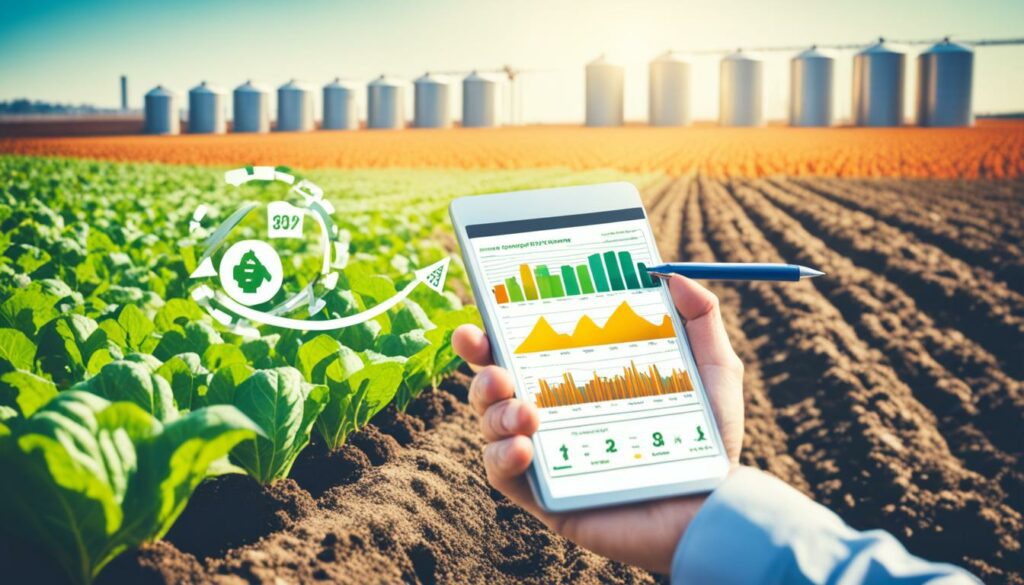
Starting with a solid financial plan is the first step in farm finance. First, look at where you stand financially. Then, set real goals and work out how to reach them. This lets farmers make clear plans and prepare for spending and new projects.
Making a budget for green farming is all about careful planning. It’s important to list the costs and benefits of being eco-friendly. With smart planning, farmers can manage their money to support these green efforts.
By planning carefully and budgeting smartly for being sustainable, farms can last a long time. They can also stay strong financially.
In the world of sustainable farming, groups without profit and local farming projects are vital. They help farmers aiming at using sustainable methods. This help includes advice, learning materials, and direct help to switch to new methods.
Non-profit agricultural groups are key in aiding sustainable farming. The Sustainable Agriculture and Food Systems Funders (SAFSF) stands out for making fair and green food systems. Their Roadmap project looks for ways to invest based on values and find money for local textile work.
This work is important for solving money problems and environmental fairness by backing projects like farming that lowers carbon and benefits the land.
Local community help is crucial too. These efforts, often started by local groups, help farming stay green, from the local to the national level. They are key in giving farmers tools, learning, and a community of like-minded people. Also, they try to help fill the gap between eco-friendly clothing brands and farmers by enhancing local fibre use.
In places like California, the Northeast, and North Carolina, these efforts help make strong local food systems. These systems meet the standards of lessening climate effects and are fair for all.
To sum up, both non-profit agricultural groups and local farming support are important in promoting sustainable farming. They bring about big changes and offer practical help to farmers.
Getting money for sustainable farming helps our planet and our money. It lets farmers use ways that are better for the Earth. This makes the environment nicer while also helping farms last a long time.
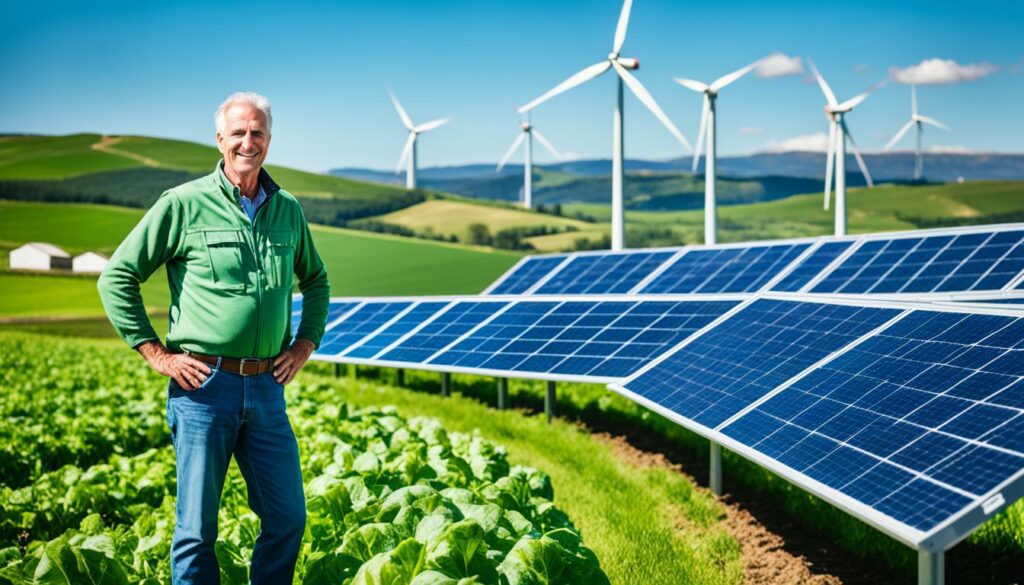
Sustainable farming grants bring lots of positive changes to nature. Things like not digging the soil a lot and planting in lines stop the ground from blowing or washing away. This also means less money spent on animal food and the grass they eat becomes better.
Using special plants after the main harvest helps the Earth too. It stops the ground from washing away, keeps weeds down, and makes the soil better. Instead of buying a lot of chemicals, farms can use natural ways to look after the soil. Planting trees with other crops is good for the environment as well.
Getting these grants also does good things for the farm’s earnings. Farmers can sell their produce straight to people at markets or on the web. This means they can make more money and share their goods with more people.
Using the money wisely helps farms to stay strong financially. Sustainable and creative ways on the farm help it last for many years. This means farming can be both a smart business and good for the planet.
For over 30 years, the Sustainable Agriculture Research and Education program, or SARE, has led sustainable agriculture education. It focuses on continuous sustainable farming research and provides farmers with new methods and technologies.
Since starting in 1988, SARE has put over $251 million into 6,300 projects to improve sustainable agriculture. Of this money, they’ve given $21 million directly to farmers and ranchers to use for their work. This support has turned into a critical help for farmers who want to do well both in money and caring for nature.
Today, SARE works on many important areas for sustainable farming. Some of these topics include:
Also, SARE gives a lot of money to help local and regional food systems, Community Supported Agriculture (CSA), and farmers’ markets. For example, in Massachusetts, sales have gone up by 65%, and some people have earned up to $35,000 more.
Over the years, SARE has funded projects all over the country. Since the early ’90s, they’ve supported many educational and research projects. A good example is a study on how tree windbreaks help against insect pests in Nebraska, which started in 1992.
Here’s a look at SARE‘s history and their work:
| Year | Project | Location |
|---|---|---|
| 1989 | Low Input and High Input Taro Production | Hawaii |
| 1992 | Impact of Tree Windbreaks | Nebraska |
| 1993 | Integrated Riparian Management | Iowa |
| 1994 | Alley Cropping for Row Crops | Indiana |
| 1995 | Orchard Alley Cropping | Hawaii |
| 1998 | Wiersema Dairy Agroforestry | Idaho |
Looking ahead, SARE expects to get $42 million more for sustainable agriculture education and research. This continued support shows SARE‘s lasting dedication to a farming system that is good for both farmers and the Earth.
Nowadays, alternative agriculture marketing is key to making more money and farming sustainably. Methods like direct marketing and online selling help farmers connect better with customers. I’ll talk about important ways to broaden the market and make supply chains stronger.
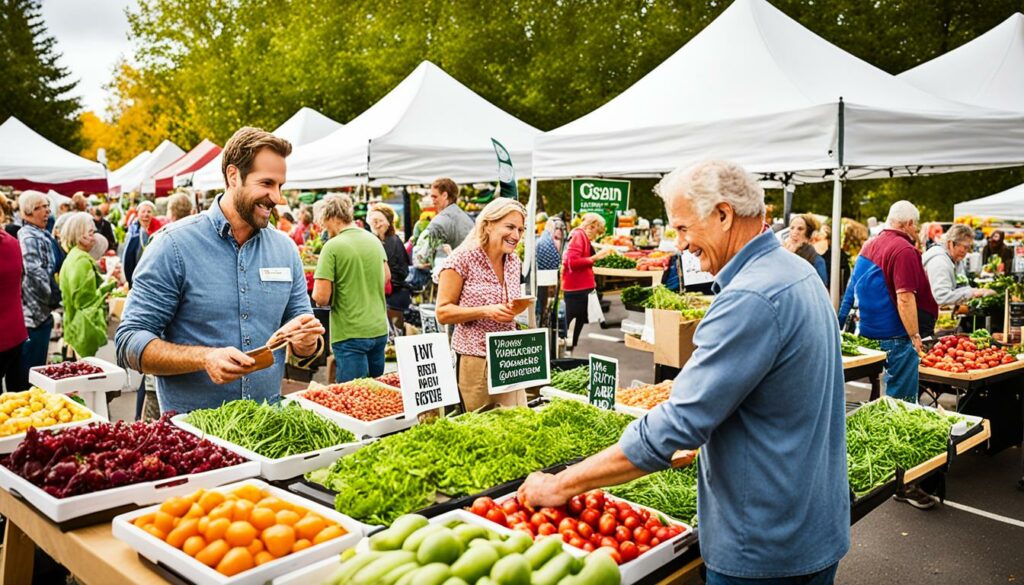
Direct farm marketing allows farmers to sell their goods straight to the people who will use them. This boosts profits and forms a closer relationship with customers. Places like farmers’ markets, farm shops, and CSA schemes are great for this. They offer fresh, local produce and support farming that is kind to the planet.
The internet has created many new ways for farmers to market their products. Using online tools means farmers can talk to more people and tailor their marketing efforts. Having a website, using social media, and selling through online shops are all helpful. E-commerce especially helps in selling customized farm products or subscriptions.
Data shows big growth in sustainable investing, up 15% to $35.3 trillion in key markets, including the U.S., from 2018-2020. Farmers can also take advantage of Supply Chain Finance (SCF), a $1.3 trillion global market. By the end of 2020, $505 billion was already in use. SCF can make farming more sustainable by rewarding green supply chains with better financial deals.
By applying these strategies, the farming sector can do well financially and help meet sustainability aims.
Getting funding for sustainable farming can be really tough. There are many hurdles farmers face to get money for eco-friendly projects. It takes a lot of knowledge, smart moves, and help to overcome these.
The main issue with getting farming funds is the complex application process. It’s a lot of paperwork and you must meet very specific rules to apply. Some farmers could be left out because of their farm’s size, the type of farm it is, or where it’s located. And many farmers don’t even know about all the funding options out there, which makes things even harder.
Another big problem is the huge amount of money going into certain farming areas. For example, the U.S. plans to spend $1.5 trillion on farming over the next 10 years. Yet, 80% of this money is aimed at a food assistance program. With so many people depending on this program, less money is left for other farming needs.
However, there are ways to fight through these challenges. Building partnerships with experts and other farmers can offer valuable help and advice. This can make the application process smoother. Also, farmers can push for changes in policies to make getting funds easier and more fair.
Having a good plan is also key. Farmers should make detailed plans that meet the funders’ goals and show their green efforts. For instance, the 2022 Inflation Reduction Act gave the Department of Agriculture a big sum for climate projects. Proposals that match these goals are more likely to win money.
Knowing the financial scene and using the help available are vital. The Agriculture Secretary pointed out that 89% of U.S. farmers didn’t make much profit in 2022, even with record earnings. This shows how careful planning and using the right resources are crucial.
To sum up, getting funds for sustainable farming takes dedication, careful planning, and good connections. By dealing with these challenges and thinking smart, farmers can improve their farms and help achieve the important goal of feeding a growing population by 2050.
Securing funds for sustainable agriculture in the US is a significant process. It involves understanding available programs, meeting eligibility, and overcoming challenges. It’s key to see the big benefits these funds bring, not just to farmers but also to the wider agricultural scene.
We see new agricultural research techniques evolving all the time. These studies often need teams of different scientists to work together. SARE resources at sare.org are critical. They offer countless projects, reports, and ideas for new agricultural solutions.
Groups like Land O’Lakes are pushing for more than 1,600 dairy farms to go sustainable by 2025. This shows great leadership. But, companies like Mars and McDonald’s also focus on the financial hurdles of going green.
Support from national farm groups and other bodies is crucial. It has helped update farm policies significantly since the New Deal. For example, over $1.1 billion has recently gone to nutrition programs. These changes show the power of working together for the future.
Moving to sustainable farming means some initial costs and learning. But, with the right support, these can be overcome. The Rodale Institute and successful cases in California and Europe prove this. They show that sustainable farming is not just good for nature, but it’s also smart economically.
The U.S. Code Title 7, Section 3103 defines sustainable agriculture. This approach aims to meet human food and fibre needs. It also works to improve the environment, save resources, and better the lives of farmers and society.
Sustainable farming aims to balance people’s needs with keeping the environment healthy. It encourages the smart use of resources and supports nature’s own cycles. This way, farm businesses can thrive and people’s lives can get better.
Many government grants focus on sustainable agriculture. These can help new farmers, support land conservation, boost the environment, and encourage partnerships like the Regional Conservation Partnership Program.
To get a grant, you might need to be a new or socially disadvantaged farmer. You should use sustainable or organic methods. You may also have to work with non-profit organisations for help and support.
The RCPP is all about having partners come together for the environment. It encourages farmers to use clever strategies that help save resources and money, while fighting climate change.
Use government schemes like the Environmental Quality Incentives Program. Also, join in on conservation projects. These usually offer to share the costs and provide help from experts.
Applying for a rural grant means explaining your farm’s plan and how it benefits from the help. You need to show why you qualify. The steps you need to follow depend on the grant you’re applying for.
Successful stories include new, disadvantaged, or veteran farmers. They used grants to make their farms more sustainable. This helped them do better and earn more.
Green finance offers money that supports eco-friendly farming. For example, farmers can get loans to build green energy sources or to protect the land in sustainable ways.
These programs help farmers make their land healthier and better for nature. They offer money and advice to make improvements that enrich the soil, keep water clean, and protect plants and animals.
Yes, every area can design its own way to help farmers stay sustainable. This means that funding can be different, but it’s made to fit the local farming needs and goals.
Key practices include planning well, putting new projects into action effectively, using smart ways to market farm products, growing different crops, and managing resources wisely.
Non-profits help by teaching farmers better ways to farm. They provide knowledge and hands-on support for moving towards eco-friendly and sustainable practices.
Sustainable funding means better care for the land. It means using resources wisely, building up the soil, saving water, and looking after the plants and creatures that live on the farm.
SARE offers money to study and spread new, sustainable farming ideas. It teaches farmers up-to-date ways to farm that benefit everyone and everything, including the environment.
To reach more people and strengthen relationships, farmers can use direct selling, online sales, and working with local communities to share their produce regularly.
The big challenges are understanding and meeting the grant rules. Also, knowing about the available help is key. To succeed, farmers must plan carefully and work with others to get the funding they need.